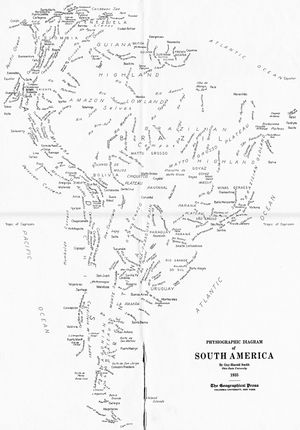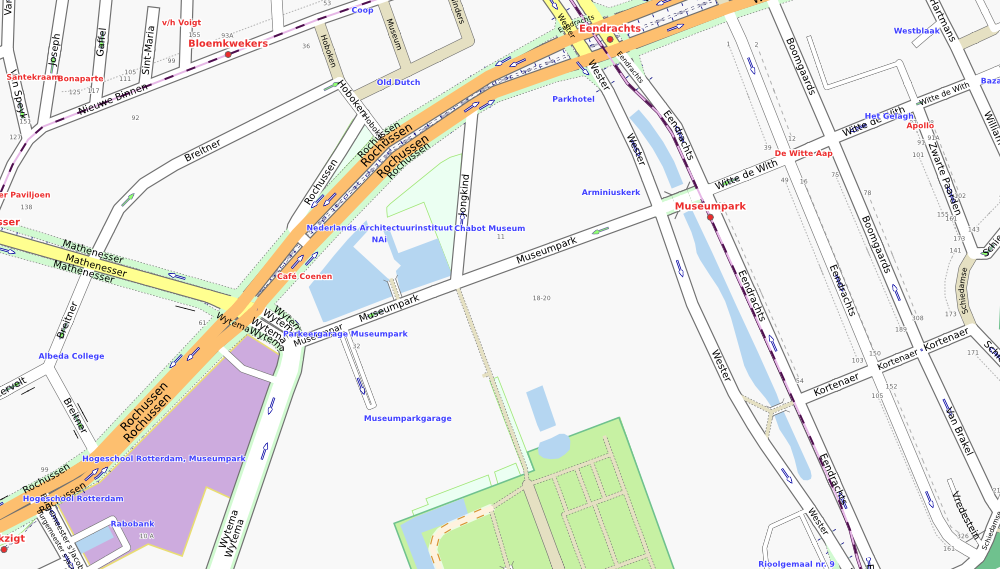UserAndre Castro/maps01: Difference between revisions
Andrecastro (talk | contribs) No edit summary |
Andrecastro (talk | contribs) No edit summary |
||
| Line 1: | Line 1: | ||
=Maps= | ==Maps / osm intro== | ||
Having recently found out [http://www.openstreetmap.org/ Open Street Map] I have been finding its various possibilities. Not only it is a open-source project that allows users to search and find information about place, but also anyone can contribute to the improvement of the maps, and the can easily be retrieved and used, for example to create new maps. | |||
I have been exploring its potential and aiming at creating non-functional maps or trajectories that could open new perspectives on the city space. (situationists echos) | |||
==New Maps== | |||
Thinking about my fascination with maps, specially unconventional maps in which accuracy and comprehension are not priorities, such as map that friend draws you on a napkin, I started to imagine what this map could be, what form could it take, what would be its purpose, how it would be displayed and navigated. | |||
Seeing in [http://makingmaps.net/2011/01/31/word-maps-words-on-maps-map-typography/ Making Maps blog] a map of South America in which a mistake prevented the map-lines from being printed. The fluidity and in nonexistence of border said something about mobility and loosening of geo-political constraints. [[File:Map-SouthAmerica.jpg|thumb]] | |||
I would be interesting to do a similar thing to a city map. What happens when your the only references are the street names? Does our vision of the city change? Will it still be possible to go from place A to place B taking the map as a reference? | |||
. | |||
This possibility also seemed to make sense with a simple idea I had been tinkering with of removing the street-name's suffixes. So in Rotterdam "Nieuwe Binnenweg" will be only represented as "Nieuwe Binnen". | |||
- . | |||
I | So I went on doing so. | ||
===retrieving osm data=== | |||
* find coordinates | |||
In [http://www.openstreetmap.org/ openstreetmap.org] go to Export Menu and check the coordinates. they organized as [lat,long, lat++, long++] area[1,3,2,0] or in other works [lat,long, lat++, long++] | |||
* wget that area's data | |||
<source lang="bash"> | |||
wget -O data.osm "http://api.openstreetmap.org/api/0.6/map?bbox=4.4552603823670465,51.91739525301985,4.46384345121436,51.920373035178464" | |||
</source> | |||
===Manipulation Data=== | |||
[[UserAndre Castro/maps01/xmlManipulate | python code]] | |||
< | <span style:"background-color=yellow">put text here. Leave code to the other page</span> | ||
===data rendering to svg osmarender=== | |||
[http://wiki.openstreetmap.org/wiki/Osmarender Osmararender] renders osm data into an svg. | |||
It is constituted of 2 files: | |||
- osm-map-features-z17.xml - is a kind of preferences file. Has to be edited in order to change the appearance of the map | |||
- osmarender.xls - instructs on how the rendering should be done. Is advised not to change it. | |||
I have started by altering the features file. For example: I remove all the elements besides the street names, or leave only lines and street names | |||
<span style="background-color:yellow">(Not sure yet)</span> It seems that when rendering, the svg becomes filled with elements which are no longer present (removed in the features-z17.xml file, therefore making it heavy and dificult to go through | |||
Next step it to apply XSLT stylesheets to XML documents using xsltproc | |||
= | <source lang="bash"> | ||
xsltproc osm-map-features-z17.xml > rendered-map.svg | |||
</source> | |||
Note: data file should be called data.osm, or otherwise osm-map-features-z17.xml data="data.osm" should be changed to the name to the file name in which is in | |||
tanttttaaaaaa! the map (svg exported to svg) | |||
[[File: render-exp-04.png]] | |||
===Map Appearance=== | |||
- | So far I have been aiming only at rendering a street-names only map. This is are the steps to get to end result | ||
I | I used xpath to parse it and remove the wished visual elements, in this case all, besides the street's name | ||
[[UserAndre Castro/maps01/features_change | changing features file - python code ]] | |||
* I also changed the svgBaseProfile.This can be set to full, basic of tinny(optimized to mobile phones) svgBaseProfie="basic" | |||
* background remove - in the svg the tag rect | |||
I order to to so I had to edit the osmarender.xsl file and commented the background background | |||
<source lang="xml"> <!-- <rect id="background" x="0px" y="0px" height="{$documentHeight}px" width="{$documentWidth}px" class="map-background"/> --> </source> | |||
== | ====osmarender xsl file==== | ||
Currently I am looking more into how to change to osmarander.xsl file, so that just the elements that are wanted are rendered into the svg. | |||
<span sytle="backgorund-color:yellow">Much work to do here | |||
* | * parsing | ||
x = lxml.etree.XSLT(doc) | |||
http://lxml.de/xpathxslt.html#xslt | |||
</span> | |||
=== | ===To Do=== | ||
* | * remove borders | ||
* make the svg file larger | |||
* | * render a bigger area - a whole city | ||
--- | |||
==OLD== | |||
Revision as of 19:55, 27 November 2011
Maps / osm intro
Having recently found out Open Street Map I have been finding its various possibilities. Not only it is a open-source project that allows users to search and find information about place, but also anyone can contribute to the improvement of the maps, and the can easily be retrieved and used, for example to create new maps.
I have been exploring its potential and aiming at creating non-functional maps or trajectories that could open new perspectives on the city space. (situationists echos)
New Maps
Thinking about my fascination with maps, specially unconventional maps in which accuracy and comprehension are not priorities, such as map that friend draws you on a napkin, I started to imagine what this map could be, what form could it take, what would be its purpose, how it would be displayed and navigated.
Seeing in Making Maps blog a map of South America in which a mistake prevented the map-lines from being printed. The fluidity and in nonexistence of border said something about mobility and loosening of geo-political constraints.
I would be interesting to do a similar thing to a city map. What happens when your the only references are the street names? Does our vision of the city change? Will it still be possible to go from place A to place B taking the map as a reference?
This possibility also seemed to make sense with a simple idea I had been tinkering with of removing the street-name's suffixes. So in Rotterdam "Nieuwe Binnenweg" will be only represented as "Nieuwe Binnen".
So I went on doing so.
retrieving osm data
- find coordinates
In openstreetmap.org go to Export Menu and check the coordinates. they organized as [lat,long, lat++, long++] area[1,3,2,0] or in other works [lat,long, lat++, long++]
- wget that area's data
wget -O data.osm "http://api.openstreetmap.org/api/0.6/map?bbox=4.4552603823670465,51.91739525301985,4.46384345121436,51.920373035178464"
Manipulation Data
python code put text here. Leave code to the other page
data rendering to svg osmarender
Osmararender renders osm data into an svg. It is constituted of 2 files:
- osm-map-features-z17.xml - is a kind of preferences file. Has to be edited in order to change the appearance of the map
- osmarender.xls - instructs on how the rendering should be done. Is advised not to change it.
I have started by altering the features file. For example: I remove all the elements besides the street names, or leave only lines and street names
(Not sure yet) It seems that when rendering, the svg becomes filled with elements which are no longer present (removed in the features-z17.xml file, therefore making it heavy and dificult to go through
Next step it to apply XSLT stylesheets to XML documents using xsltproc
xsltproc osm-map-features-z17.xml > rendered-map.svg
Note: data file should be called data.osm, or otherwise osm-map-features-z17.xml data="data.osm" should be changed to the name to the file name in which is in
tanttttaaaaaa! the map (svg exported to svg)
Map Appearance
So far I have been aiming only at rendering a street-names only map. This is are the steps to get to end result
I used xpath to parse it and remove the wished visual elements, in this case all, besides the street's name changing features file - python code
- I also changed the svgBaseProfile.This can be set to full, basic of tinny(optimized to mobile phones) svgBaseProfie="basic"
- background remove - in the svg the tag rect
I order to to so I had to edit the osmarender.xsl file and commented the background background
<!-- <rect id="background" x="0px" y="0px" height="{$documentHeight}px" width="{$documentWidth}px" class="map-background"/> -->
osmarender xsl file
Currently I am looking more into how to change to osmarander.xsl file, so that just the elements that are wanted are rendered into the svg. Much work to do here
- parsing
x = lxml.etree.XSLT(doc) http://lxml.de/xpathxslt.html#xslt
To Do
- remove borders
- make the svg file larger
- render a bigger area - a whole city
---
OLD
- Info sources:
http://www.use-it.be/europe/docs/OSMmanual/
http://wiki.openstreetmap.org/wiki/Osmarender
Other Possibilities
- GPS traces
- Topographic map
OSM Elements
source: http://wiki.openstreetmap.org/wiki/Map_Features
maps are made up of a few simple elements (Data primitives): nodes, ways and relations. Each element may have an arbitrary number of properties (a.k.a. Tags) which are Key-Value pairs (e.g. highway=primary). (All editing interfaces use the elements and allow the input of tags. )
NODE - the basic element, building block. Nodes consist of latitude and longitude
(Nodes are needed to define a way, but a node can also be a standalone unconnected point representing something or points of interest (POI). Standalone nodes should always have at least one Tag such as amenity=telephone).
Example <node id="25496583" lat="51.5173639" lon="-0.140043" version="1" changeset="203496" user="80n" uid="1238" visible="true" timestamp="2007-01-28T11:40:26Z"><tag k="highway" v="traffic_signals"/>
</node>
WAY - ordered interconnection of at least 2 or more nodes can describe a street, footpath, railway line, river, fence, power line, area or building outline. CLOSED WAY - the first and last nodes are identical, enclosing an AREA
Databases and data acess APIs
http://wiki.openstreetmap.org/wiki/Databases_and_data_access_APIs
API
The main API is the method of obtaining OSM data used by editors. Its limitations are that it will only return very small areas <0.25deg square.
This method of obtaining data should therefore be reserved for editing applications
TRAPI=
XAPI - Retrieve Particular Data Request Needs to be edited
To acess data of a given area in http://www.openstreetmap.org/ go to Export Menu and check the coordinates. they organized as [bbox=lat,long, lat++, long++] area[1,3,2,0] or in other works [lat,long, lat++, long++]
EXAMPLES:
search all nodes in a small are in west Rotterdam:
wget http://open.mapquestapi.com/xapi/api/0.6/node[bbox=4.4552603823670465,51.91739525301985,4.46384345121436,51.920373035178464] -O rotterdam-west-test.osm
search pub nodes in Rotterdam
wget http://open.mapquestapi.com/xapi/api/0.6/node[amenity=pub][bbox=4.3142405612056836,51.87797066611181,4.588898764319719,51.973245376533505] -O rotterdam-pub-test.osm
search ways in a small area in west Rotterdam:
wget http://open.mapquestapi.com/xapi/api/0.6/way[bbox=4.4552603823670465,51.91739525301985,4.46384345121436,51.920373035178464] -O rotterdam-west-way-test.osm
Ways are where I can gather information about streets
Ways get rendered as streets/railways/footpaths/canals etc according to the tag(s) indicating what type of way it is. Ways are contiguous and non-branching. (You can get from beginning to end by following segments of the way, without "jumping" or backtracing)
eg: <tag k="addr:street" v="Mauritsstraat"/>
eg:
<way id="5090250" visible="true" timestamp="2009-01-19T19:07:25Z" version="8" changeset="816806" user="Blumpsy" uid="64226"> <nd ref="822403"/> <nd ref="21533912"/> <nd ref="821601"/> <nd ref="21533910"/> <nd ref="135791608"/> <nd ref="333725784"/> <nd ref="333725781"/> <nd ref="333725774"/> <nd ref="333725776"/> <nd ref="823771"/> <tag k="highway" v="unclassified"/> <tag k="name" v="Clipstone Street"/> <tag k="oneway" v="yes"/> </way>
All Elements
All elements (nodes, ways and relations) that match the given filter predicates can be requested using the following URL:
http://www.informationfreeway.org/api/0.6/*[...]
This returns an xml document containing nodes, ways and relations that match the search terms. For each matching way the nodes and referenced by that way are also returned. Likewise, for each matching relation the ways and nodes referenced by that relation are also returned.
Source: http://wiki.openstreetmap.org/wiki/Xapi
relevant links
http://derickrethans.nl/what-is-openstreetmap.html Good explanation of OSM project
http://weait.com/content/openstreetmap-planet-file
http://derickrethans.nl/spatial-indexes-data-sqlite.html
Pyrender-map rendering framework, programmed in Python
Databases and data acess APIs
http://wiki.openstreetmap.org/wiki/Databases_and_data_access_APIs
xpath tutorials
http://infohost.nmt.edu/tcc/help/pubs/pylxml/web/index.html#intro


